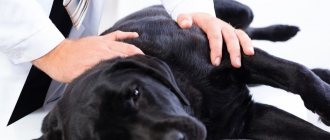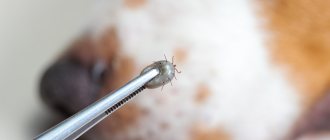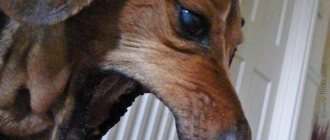City dwellers need not fear snakes. But as soon as you go to the dacha or for a walk in the forest, there is a real chance of encountering a viper. This is the danger of such a meeting - it happens far from the city, far from qualified veterinary care.
If there is information about snake activity in the region, cases of bites, or you simply regularly visit the forest in the warm season, it is better to prepare a first aid kit for your pet and take it with you. It must contain a set of medications that you can administer yourself if your dog is bitten by a snake.
A viper attacked my dachshund right at my summer cottage. More precisely, the dog probably attacked first. Many hunting breeds will chase anything that jumps, runs or crawls. Even the friendliest and calmest dogs, out of curiosity, stick their snouts into a snake if it comes across it on the way.
Author of the article: Olga Shiltsova, practicing veterinarian, author of the books “Dachshund of Fate” and “Tails of Fortune”
Poisonous snakes living in Russia
There are significantly fewer poisonous reptiles on the territory of the Russian Federation than in Asia or Africa, but all of them are dangerous to humans and animals.
Poisonous snakes:
common copperhead;- Ussuri copperhead;
- rocky muzzle;
- tiger snake;
- common viper;
- Caucasian viper;
- Dinnik's viper;
- steppe viper;
- Nikolsky's viper;
- viper
Black viper - the most dangerous
The black viper, or Nikolsky's viper, lives in the European part of Russia, forest-steppes and steppes, at the foothills of the Middle and Southern Urals. The reptile's activity occurs during the daytime.
The poison is dangerous because when it gets into the blood, it destroys red blood cells. The viper is very dangerous for small animals, since snake venom quickly spreads through the circulatory system, it is enough to kill a small animal or a child.
Cottonmouth
This type of snake does not show aggressiveness, but will definitely attack if you step on it.
Cottonmouth bites cause hemorrhages in the internal organs, and ulcers also appear in places where teeth are punctured. Neurotoxins paralyze the nervous and respiratory systems. Children and small animals are especially likely to die from a copperhead bite.
If you provide first aid and start treatment in a timely manner, the victim’s condition will improve within a week.
Dangerous places for dogs
The best prevention of a snake bite is to avoid places where dangerous reptiles most often live. Potentially dangerous places for walking in wooded areas, especially with pets, are peat bogs, well-lit areas with high humidity.
In the overwhelming majority of cases, snakes prefer to hide in various crevices of old trees and under snags, crawling out of their shelter solely for the purpose of warming themselves during the daytime.
The most common viper in the vast expanses of the European part of the country is the common viper. The dangerous reptile can have a color from brown to silver with a specific diamond-shaped pattern on the back. In some cases, the color of the viper may be without a pattern, black. Poisonous substances - toxins contained in special capsules of the snake's teeth, provoke hemorrhagic edema, and also have necrotizing and hemocoagulating effects.
Properties of snake venom
It is a complex mixture of organic and inorganic substances produced by the glands of poisonous snakes.
The poison has a neurotoxic effect: it blocks the transmission of signals from the brain to the muscles, the animal or person dies from paralysis.
The second property is a hemovasotoxic effect. After snake venom enters the blood, vascular spasm occurs, arteries become permeable, and swelling of tissues and internal organs occurs.
How to tell if your dog has been bitten by a snake
Usually the upper part of the body is injured: the area of the head, neck or muzzle, and animal paw bites are not uncommon.
Inspection
It is necessary to examine the animal as quickly as possible and find the site of the bite. If a dog is attacked by a poisonous snake, the damage is extensive and 2 punctures are found. The site of injury swells, tissue swelling appears, blood begins to ooze, and the animal whines in severe pain.
If the dog encounters a non-venomous snake, the wound will look like an injection and will not cause much discomfort.
Important symptoms
After repeated snake bites, 2–4 or more wounds remain. The skin around them acquires a purple tint and later becomes insensitive. Within a minute, a large, painful swelling forms.
The swelling spreads to the entire face or paw, the animal limps, behaves restlessly, indicating that it is in severe pain.
Half an hour later, the dog has difficulty swallowing, rapid heartbeat, shortness of breath, and convulsions. Vomiting, bleeding from the gums, and lethargy followed by restless behavior are less common.
First aid for a snake bite
Due to the warming climate on planet Earth, the number of poisonous snakes in our latitudes is constantly growing. In this regard, the number and severity of their bites increases. There are viper snakes (viper snakes) and slate snakes (elapids). The common viper lives in Belarus. Poisoning by snake venom causes severe specific general and local symptoms. It is very important to have information about the rules for carrying out measures to provide emergency assistance to victims.
The severity and nature of symptoms from snake bites can be characterized by some common features, since snake venoms contain the same components that have similar effects on the human body. These toxins include the following:
- neurotoxin – affects and causes dysfunction of the nervous system
- Cholinesterase is an enzyme that causes disruption of the transmission of nerve impulses from nerves to muscles
- cardiotoxin – affects and causes disorders in the functioning of the cardiovascular system
- hemolysin – provokes the destruction of blood cells and red blood cells
Symptoms that appear in a victim after a snake bite can be divided into:
- general - appear when bitten by any poisonous snake and are expressed with varying degrees of intensity
- specific - characteristic of poisoning by a certain type of snake venom
General symptoms
Common symptoms of snake bites and poisoning include:
- Local signs. One or two triangular-shaped wounds are identified on the skin. They measure about 2-3 mm and are located on the same level. In the area of the bite, the following signs of inflammation are detected: redness, swelling and burning sensations and pain. The wounds may produce bloody discharge, and the skin surrounding the bite site may have hemorrhages or bluish spots.
- General reactions: temperature rises (to high numbers), muscle pain, nausea, vomiting and loose stools with blood appear. Renal and hepatic failure gradually increases.
- Neurological disorders: there is a feeling of muscle weakness, confusion, numbness (especially in the bite area), headaches, decreased visual acuity, double vision, inability to focus, distortion of the facial muscles, drooping eyelids and impaired swallowing.
- Disorders of cardiovascular activity: the pulse quickens, blood pressure decreases or increases (sometimes to critical figures), breathing quickens and pain appears in the heart and chest.
The severity of symptoms of snake venom poisoning depends on many factors:
- The behavior of the victim after the bite. Running, fast movements, walking or panicking accelerate the rate at which the poison spreads throughout the body.
- Type of snake, its size and age. The most dangerous are the bites of rattlesnakes, adders and cobras, less so are the bites of snakes of the viper family, but they can also cause serious deviations and death (in 1% of cases). Poisoning from young or small snakes is less dangerous. In addition, the toxicity of the venom can also be influenced by the degree of fear of the snake before the attack: the more frightened and aggressive the snake is, the more toxic its venom becomes.
- Localization of the bite. Symptoms of poisoning develop more quickly when a bite is applied to the head, neck, torso and large blood vessels. When the lower extremities are affected, symptoms develop more slowly.
- Age and general health of the victim. Children, elderly people, women and people suffering from serious illnesses or under the influence of alcohol are more susceptible to snake venom toxins. In such cases, death can occur at lightning speed.
- The presence of pathogenic bacteria on the snake's teeth. Wound infection can cause the development of severe purulent complications, necrotic processes and sepsis.
- High air temperature. A hot climate promotes faster blood flow through the vessels and the spread of poison.
All these factors contribute to the increase and progression of the general symptoms of snake venom poisoning. Depending on their combination and severity, the signs of poisoning can be aggravated by layering on each other or immediately causing the development of a shock reaction and the rapid onset of death of the victim.
First aid for a snake bite is as follows:
- Lay the victim in a horizontal position and calm him down. Once the snake is attached to the skin, it is removed immediately. If possible, the snake is identified or killed for further examination by a specialist
- Call an ambulance (if possible)
- Remove clothing and jewelry from the affected area, which can impair circulation and worsen swelling.
- If it is known for sure that the bitten snake is poisonous, then first aid measures begin immediately.
Urgent Care
- Immobilize the affected limb (immobilize) using an improvised bandage or splint.
- Suction of the venom should be carried out in the first 5-10 minutes after the bite is applied, since at a later date it is no longer so effective. Timely implementation of this emergency measure helps remove about 50% of the poison from the body. If possible, it is better to use suction or a rubber bulb for this procedure, and if they are not available, suction is performed with the mouth. To perform suction, you should grab the skin at the puncture site in a fold and lightly knead it (this will allow the puncture sites to open up better from the teeth). Use your teeth to grasp the areas of skin surrounding the wounds and suck out the poison while pressing on the skin. Saliva containing poison should be spat out immediately. The same actions should be performed for 20 minutes.
- Disinfect the wound with hydrogen peroxide, chlorhexidine, a weak solution of potassium permanganate or brilliant green. It is better not to use alcohol or alcohol solutions to treat a wound.
- Apply a loose bandage made of clean cloth or bandage to the wound and a moderately compressive bandage over the entire limb (the finger should freely penetrate under the surface of the bandage and not cause discomfort to the victim).
- Apply cold to the bite site. When using ice, it should be removed every 5-7 minutes (to prevent tissue frostbite).
- To reduce the symptoms of intoxication, the victim should drink as much as possible (up to 3-5 liters of drinking or alkaline mineral water per day), take vitamin K and C. Alkalinization of water can be done by preparing a soda solution: 1-2 teaspoons of soda per 1 liter water. If possible, a dropper with a 5% glucose solution (400 ml) should be placed.
- Give the patient to take antihistamines (Diphenhydramine, Loratadine, Tavegil, Levocetirizine) or administer intramuscularly (1 ml of 1% solution of Diphenhydramine, Pipolfen or Suprastin).
- Give the patient to take glucorticoid drugs (Dexamethasone - 2-4 mg/day, Prednisolone - 5 mg/day) or administer them intramuscularly (Prednisolone - 30-60 mg, Dexamethasone - 80 mg).
- If there are signs of respiratory and heart failure, the patient is administered Cordiamin, Ephedrine and Caffeine.
- When breathing and cardiac activity stop, artificial respiration and indirect cardiac massage are performed.
Antidotes
In case of poisoning with snake venom, the administration of antidotes - antisnake serums - is indicated. Their administration is most effective in the first hours or days after the bite. Subsequently, if necessary, the administration of serums can be repeated.
Providing first aid to a person bitten on the spot.
The victim is placed in the shade and given plenty of fluids: tea, milk, broth, water (the use of alcoholic beverages is contraindicated) and 1 therapeutic dose of serum is administered, regardless of the body weight of the bitten person. To avoid anaphylactic shock or other allergic complications, before administering the serum, the victim is given 1-2 tablets of any antihistamine (diphenhydramine, pipolfen, tavegil, etc.) orally. The serum is injected subcutaneously in fractional increments (according to Bezredka) into any part of the victim’s body: first 0.1 ml, if there is no reaction after 10-15 minutes, 0.25 ml is injected and then after 15 minutes, if there are no adverse reactions, the rest of the serum.
After providing first aid, it is necessary to ensure immediate hospitalization of the victim to the nearest medical facility, where treatment will continue. The patient is transported in a supine position. The bitten leg is bandaged to the healthy one; if the hand is bitten, it is fixed in a bent position with the help of a cloth thrown over the neck.
Assistance in a medical facility.
The total dose of serum administered is determined by the doctor depending on the degree of intoxication: for mild degrees, 1-2 doses intramuscularly, for severe cases, 4-5 doses, taking into account the dose administered before hospitalization. It is necessary to carry out measures for emergency prevention of tetanus in accordance with the instructions for the prevention of tetanus.
Treatment for poisoning by snake venoms
Treatment of snake venom poisoning should be comprehensive and include symptomatic, detoxification and specific therapy. If necessary, resuscitation measures and artificial ventilation are carried out.
Preventing snake bites
There are no specific ways to prevent poisonous snake bites.
To prevent snake bites, the following rules of conduct should be observed:
- When you see a snake, you should not perform actions that provoke the snake to attack: scream, tease, or make sudden movements.
- When entering a potential risk area, be sure to wear boots or high boots and thick clothing.
- If you are walking through tall grass, use a stick to make sure there is no snake.
- When walking in snake habitats, watch your step.
- When in places that are remote from cities and medical institutions, carry medications with antidotes.
- When staying outdoors for a long time in tents or sleeping bags, carefully choose a suitable place to sleep. It should be located on a hill with low vegetation, away from mountains and rocks.
- Be sure to check tents and sleeping bags for snakes whenever you need to use them.
Surgeon 1x/o Nikolaeva O.S.
What happens after a bite
Consequences after a snake attack: blood flowing from damaged skin forms clots, the poison remains in the wound and is carried through the bloodstream.
The red blood cells inside the wound coagulate under the influence of the poison, oxygen does not reach the tissues, as a result of which they die. In the bites left by reptiles, non-healing painful ulcers develop and the skin peels off.
More severe consequences: an allergic reaction and anaphylactic shock, the dog dies within a few minutes. If a snake's teeth get into a vessel, the poison spreads faster through the bloodstream, causing irreversible changes.
The pet's death occurs within 48 hours after the bite.
First aid
You need to react quickly. Sucking the poison from the wound or blocking the blood flow with a tourniquet is useless.
First aid should consist of preparing the pet for examination by a veterinarian:
- The animal is calmed down, talked to, taken to a safe place, and prepared for the veterinarian’s arrival.
- The dog is immobilized and placed on its side: this way the poison spreads more slowly throughout the body.
The owner examines her and finds the bite site.- If the owner is sure that the snake attacked the dog no more than 20 minutes ago, the poison can be squeezed out of the wound: the substance is still there and has not been spread by the blood throughout the body.
- Call a veterinarian or take the animal to the clinic. In this case, you cannot self-medicate.
The owner should not panic. If the dog is large, then the dose of poison that the snake injects in defense at one time is not enough to cause death.
A small pet may suffer more.
Why do snakes attack?
In fact, snakes never attack people or dogs for no reason or out of bad character. The fact is that snake venom is intended to immobilize and improve the digestion of prey. The reserves of poison are replenished only after some time, during which the snake calmly digests the food. A snake can go without food for a month or even more. A person, dog or cat is too large to be prey for a snake, and the valuable supply of poison spent on a bite will take a long time to be replenished in the snake’s body. Therefore, snakes bite people and large animals only in self-defense. Let's say it was stepped on or a dog poked its nose in to sniff the snake.
What not to do
Many dog owners, when they discover snake bites, begin to panic and make mistakes that can lead to dire consequences:
A tourniquet is applied. When tissue is compressed, the concentration of poison increases; as soon as the tourniquet is released, the substance rapidly spreads throughout the body through the bloodstream.- They try to suck out the poison from the wound: it is difficult to find the bite site, the dog will not always let you touch it.
- Treat wounds left after snake bites. This is useless and may increase pain. Antiseptic solutions containing alcohol and ethers enhance the absorption of toxins.
The only thing the dog owner can do is apply ice wrapped in a towel to the wound. This slows down metabolic processes at the site of poison injection and reduces pain in the pet.
What is strictly forbidden to do
A dog was bitten by a wasp in the paw or face: what to do?
As practice shows, most dog owners make the same mistakes in stressful situations. What is strictly forbidden to do when dogs are bitten by snakes:
- Administer medications intramuscularly or intravenously (including snake serum) without a veterinarian's prescription. Incorrect dosage calculation may not only fail to provide the desired therapeutic effect, but also aggravate the situation.
- Apply a pressure bandage or tourniquet above the bite site.
- You should not give your pet any products that speed up the heart rate, for example, tea, coffee, alcohol. To avoid dehydration, your pet should drink plenty of fluids.
- Cauterize the bite site, suck out the poison.
The first thing after a bite is to provide the dog with complete rest, cover it with a warm blanket, and apply a cold compress to the bite site. If possible, give a diuretic to relieve swelling. As soon as the condition has stabilized a little, the animal should be shown to a veterinarian. It is recommended to show the dog to a doctor within the first hour after the incident.
Veterinarian actions
The dog is admitted to the hospital.
At the clinic, the doctor conducts a general examination of the pet, assesses its condition, the degree of intoxication, and the functioning of the internal organs. The veterinarian then places an intravenous catheter in the dog through which the necessary medications are administered.
The doctor may prescribe a biochemical blood test to determine the extent of the poison's effect on the pet's body.
If the owner of the animal has determined which reptile attacked the pet, the appropriate antidote is administered at the clinic.
Therapy
If the type of snake is unknown, antihistamines are administered: Dexamethasone, Suprastin. They relieve swelling and reduce allergic reactions.
Furosemide is also prescribed against edema. To maintain blood circulation, the dog is given sodium chloride or Ringer's solution. To protect against secondary infection, antibiotics are administered for a week.
The bite site is anesthetized with Novocaine solution, then the animal is given sedatives. In severe cases, blood or plasma transfusions are recommended.
How to keep your dog safe
Protecting your pet from snake bites is quite difficult. At the moment there are no special repellents or deterrent devices.
It is better to avoid going outdoors in the spring, since it is during this period that snakes are especially active and their venom is concentrated after a long winter.
Young dogs are very inquisitive and playful, and are more likely to become victims of snake bites than their more experienced counterparts.
Dogs of hunting breeds often suffer from snakes, as they mistake them for prey. These pets are closely monitored. It is important to know that these dogs are the least susceptible to snake venom.
It is better not to let very small decorative dogs go “free swimming” at all - such an adventure can be fatal for them.
The dog owner, when going for country walks, should always have a first aid kit with antihistamines, including Suprastin, Allergostop, and corticosteroids (Dexamethasone, Prednisolone).
Reasons why a viper may bite
Reptiles bite mainly only at the moment when they feel danger. For example, the dog discovered her and began to crawl towards her with his muzzle and nose. For the viper, this looks like an attack and it strikes first. Most often they are found in forests and parks.
Viper attack on a dog
What types of snakes are dangerous?
The most dangerous species of snakes are those that live in the southern regions of Russia, but poisonous reptiles are also found in the north of the country. More details about each type:
- Efa belongs to the viper family. The poison is similar in chemical composition and effect on living organisms to the venom of a viper. Prefers to live in warm latitudes - Central Asia and northern Africa. Adults can reach a length of 90 cm.
- The common viper is common in the temperate climate zone. In nature, it can be found all the way to the Arctic Circle. This is perhaps the most common poisonous representative of the species in Asia and Europe. A characteristic and distinctive feature of the viper is a zigzag pattern on the back, but there are also individuals with a uniform dark color. Adult snakes reach a length of 80-90 cm. The further north the habitat is, the larger the representative will be.
- Cobra is the collective name for snakes that belong to the Aspid family. These include forest, shield, spitting and king cobras. Their habitat is southern latitudes - South America, Central Asia, Southeast Asia and Africa.
- Viper is another bright representative of the viper family. Adults can reach two meters in length. Unlike ordinary vipers, it is found further south - in the countries of Transcaucasia, Central Asia and the Mediterranean. This is the most dangerous representative that can be encountered on the path of pets. The venom is deadly and is second only to cobra venom in toxicity.
- Rattlesnakes get their name because of the horny formation on their tail, a rattle that warns others of danger and scares away enemies. Found in South and North America.
This is what a common viper looks like
These are the most common and dangerous representatives of reptiles, which can cause serious damage to the health of a pet or even take its life.











